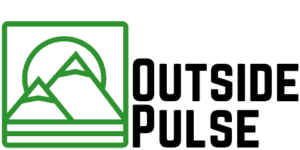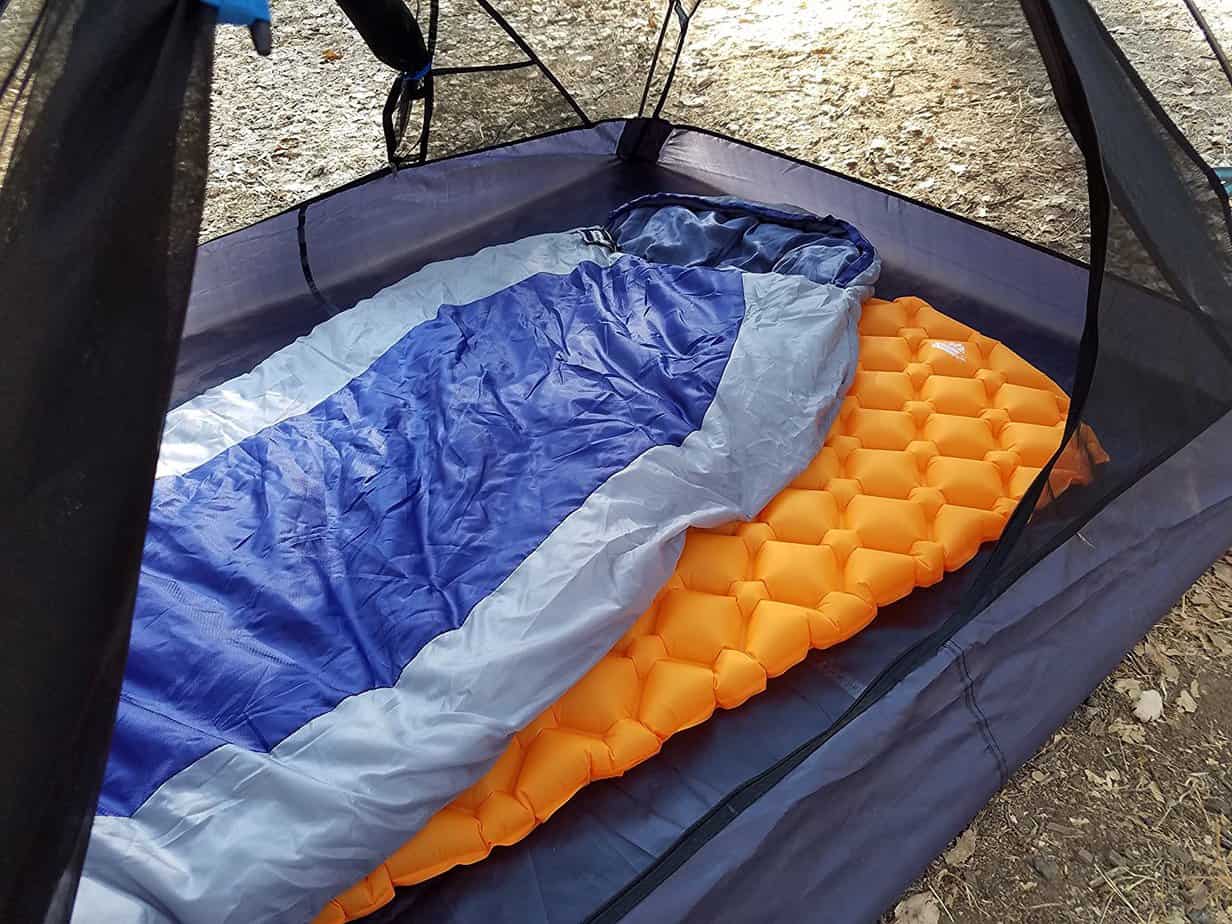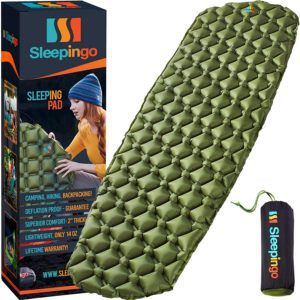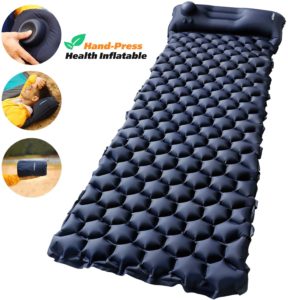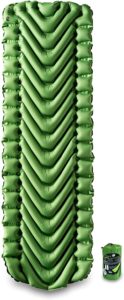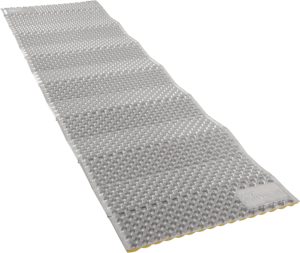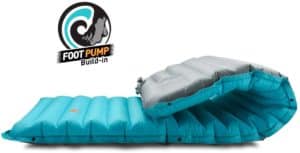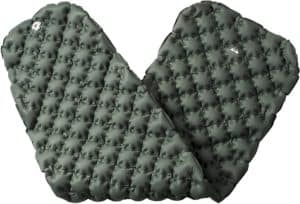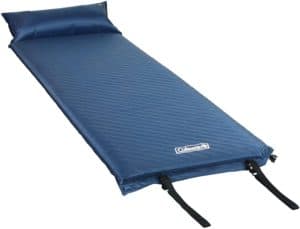Recently I was looking to replace my old worn-out sleeping pad I have had for years but I didn’t want to spend a ton of money and was trying to keep the price under $50.
So I did a ton of research on the best sleeping pads under $50, and when I finished I thought this information might be super helpful to other campers looking for a quality sleeping pad for a cheap price.
So I put all the information I learned while looking for my own sleeping pad into this extensive and helpful how-to guide on picking the best sleeping pad under $50.
Best Sleeping Pads Under $50
While some of the more expensive sleeping pads can cost over or close to a hundred dollars what I found when I was doing my research is that you actually don’t have to spend a fortune to get a quality and well-made sleeping pad for camping.
Below are my favorite and highest rated sleeping pads that I could find on the market today.
Sleepingo Camping Sleeping Pad
- Why It’s Great: Most Highly Reviewed
- Weight: 14.5 oz
- Size: 75″ x 23″
- Thickness: 2″
- Cushioning: Air
The Sleepingo Camping Sleeping Pad is one of the highest-reviewed sleeping pads currently on the market today and it’s easy to see why due to its durable construction and lightweight and compact design.
This sleeping pad is great for any backpacker, camper, or hiking looking for a light and affordable sleeping pad that won’t break the bank.
As the pad only weighs 14.5 ounces and when stored in its carrying case it’s only about the size of a water bottle. Making it super easy to store in your pack, in fact, it’s so lightweight and small you might actually even forget it’s in your pack until it’s time to set up camp for the evening.
While this camping sleeping pad is not the thickest pad you will find on the market, at 2 inches thick it is more than thick enough to accommodate any sleeping style you might prefer whether on your back, side, or stomach.
Also, for those concerned for their lungs knowing this sleeping pad is filled with air, take comfort in knowing that it actually only takes about 10 to 13 breaths to fill the sleeping pad due to its chamber honeycomb design.
So if your looking for a great all-around, highly-reviewed sleeping pad than this sleeping pad by Sleepingo might just be for you.
To check the price of this sleeping pad on Amazon click here.
AirExpect Camping Sleeping Pad with Built-in Pump
- Why It’s Great: Built-in Pump
- Weight: 21 oz
- Size: 77″ x 22″
- Thickness: 2.5″
- Cushioning: Air
One of the more unique sleeping pads on this list is this pad by AirExpert due to its built-in pump that allows you to fill the sleeping pad without turning blue. Instead, this sleeping pad has a small gasket built-in at the top near the pillow that inflates the pad when depressed.
Be forewarned though that this manual pump will require a lot of pumps to actually fill the sleeping pad. So while you might not have to huff and puff into the mattress you will have to depress the pump I would estimate at least 50 times or more to fully inflate the sleeping pad.
Thanks to this sleeping pads thickness of two and a half inches it also provides a great amount of loft and thanks to its built-in pillow it really provides a lot of comfort for a portable camping sleeping pad.
This sleeping pad by AirExpress is a great sleeping pad for those campers that don’t want to have to inflate their sleeping air pad by breath but want more loft and comfort than what foam sleeping pads usually provide.
To check the price of this unique sleeping pad with built-in pump on Amazon click here.
Klymit Static V Lightweight Sleeping Pad
- Why It’s Great: Unique V-Shaped Baffles
- Weight: 20 oz
- Size: 72″ x 23″
- Thickness: 2.5″
- Cushioning: Air
This v-shaped lightweight sleeping pad by Kylmit Static is a great all-around air-filled sleeping pad that is great for both backpackers and campers.
One of the first things you notice about this air-filled sleeping pad is its unique v-shaped baffles across the top but these v-shaped baffles aren’t just for looks as they actually serve several purposes.
There are three main advantages to the unique v-shaped baffle design on this sleeping pad which includes reducing the internal air movement inside the pad, prevents heat loss as the warm air under your body is trapped by the individual baffles, and helps to keep you on the sleeping pad better as the v-shape of the baffles provides resistance on side to side movement.
This sleeping pad as you might expect is also great to travel with as it’s both compact and lightweight weighing only 20 ounces and not much larger than a water bottle when packed away.
While this particular sleeping pad does require you to fill the pad with air from your breath it usually only takes somewhere between 10 to 15 breaths to completely fill the sleeping pad.
To check the price of this highly rated and unique v-shaped sleeping pad on Amazon click here.
Therm-a-Rest Z Lite Sol Ultralight Foam Sleeping Pad
- Why It’s Great: Extremely Durable
- Weight: 14 oz
- Size: 72″ x 20″
- Thickness: .75″
- Cushioning: Closed-Cell Foam
If you’re looking for a sleeping pad that uses something other the air for cushioning, a great option to consider is the Therm-A-Rest Z Lite Sol Sleeping Pad as it uses closed-cell foam instead of air for cushioning.
There are two main benefits to using a closed-cell foam pad as opposed to an air-filled pad including a more even and continuous support as well as a more rugged and reliable design as there is nothing to fail with a closed-cell foam pad as it can’t be punctured or deflated.
There is one negative though when it comes to closed-cell foam sleeping pads including this one which is they don’t pack down as small as an air-filled pad.
While closed-cell foam pads are usually just as light as most air-filled sleeping pads, they are typically bulkier in size when packed down compared to their air-filled counterpart.
This is because closed-cell foam can only be reduced in size by so much as the foam will always hold and maintain its shape. While the closed-cell foam sleeping pad can be folded or rolled up it’s still usually twice as large when comparing it to an air-filled sleeping pad when stored.
Moving beyond the storage size limitations though, a great feature of this sleeping pad is that it provides a great barrier of protection from the cold ground with an R-value of 2.6. And thanks to the unique dimpled design of this pad it actually traps 20% more body heat when compared to your standard flat closed-cell foam sleeping pad.
To check the price of this closed-cell foam sleeping pad on Amazon click here.
ZOOOBELIVES Extra Thick Inflatable Sleeping Pad with Built-in Pump
- Why It’s Great: Extra Thick Camping Sleeping Pad
- Weight: 49.4 oz
- Size: 74″ x 24″
- Thickness: 4″
- Cushioning: Air
One of the thickest and most comfortable camping sleeping pads on this list of top sleeping pads under $50, is this extra-thick sleeping pad by Zooobelives coming in at a whopping four inches thick.
While this sleeping pad won’t give you the same feeling as sleeping at home on your mattress, with its four inches of thickness, in my opinion, this is about as close as you can get and still keep the portability of a camping sleeping pad.
While the sleeping pad at almost 50 ounces is not going to win any lightweight prizes and is best suited for car camping, it still does pack down to the reasonable size of 6″ x 6″x 14″ and weighs about the same as a standard-sized bag of sugar.
This sleeping pad also comes with a built-in foot pump for airing the sleeping pad up, so there is no need to worry about huffing and puffing to fill this four-inch-thick pad. Instead, with its handy built-in foot pump, you can fill the sleeping pad up with the ease of your foot after about 3 minutes of pumping.
If you’re looking for the smallest and most lightweight sleeping pad for backpacking than this is not a good choice for you. If however, you are looking for the ultimate in comfort when it comes to camping sleeping pads and don’t mind a little extra weight and bulk than this camping sleeping pad might just be the right one for you.
To check the price of this ultimate in comfort sleeping pad on Amazon click here.
WELLAX Ultralight Air Sleeping Pad
- Why It’s Great: Ultra Light
- Weight: 14.5 oz
- Size: 78″ x 24″
- Thickness: 2.5″
- Cushioning: Air
One of the lightest sleeping pads on this list is this ultralight camping sleeping pad by Wellax coming in at just over 14 ounces. But don’t think you will have to sacrifice on comfort just because this sleeping pad is so light as the pad is still two and a half inches thick proving plenty of comfort and warmth while camping.
While you do have to inflate this sleeping pad with your breath it has one of easiest and quickest inflate times, only requiring about 6 to 8 breaths to fully inflate.
In addition, this sleeping pad is made from tuff and durable 20D ripstop nylon which will help to make sure that this sleeping pad is with you for years to come thanks to its rugged materials and design.
If you are a backpacker or just someone that wants to travel light while camping this ultralight sleeping pad by Wellax is a great choice.
To check the price of this ultralight sleeping pad on Amazon click here.
Coleman Self-Inflating Camping Pad
- Why It’s Great: Self-Inflating
- Weight: 80 oz
- Size: 76″ x 25″
- Thickness: 2.5″
- Cushioning: Air
A comfortable option if you are not concerned about weight is this self-inflating sleeping pad by Coleman.
While this sleeping pad is not a good fit if you’re a backpacker or hiker. If your car camping and don’t have to worry about weight or size this sleeping pad is great for comfort and ease of use.
And with a name like Coleman you know that you can trust in the quality as Coleman has been making outdoor and sporting gear for over 100 years.
Another great feature of this sleeping pad is that its self-inflating, meaning you don’t have to huff and puff to blow it up or even step on a foot pump hundreds of times. As all you have to do is unroll the sleeping pad and give it about 5 minutes for it to fully self-inflate itself.
While as mentioned above this is not a good choice if you are concerned about the weight of your sleeping pad, it is one of the higher-rated sleeping pads when it comes to comfort so it’s definitely worth checking out if you’re looking for the most comfortable and restful night’s sleep while camping.
To check the price of this comfortable self-inflating sleeping pad by Coleman on Amazon click here.
How to Choose the Best Sleeping Pad under $50
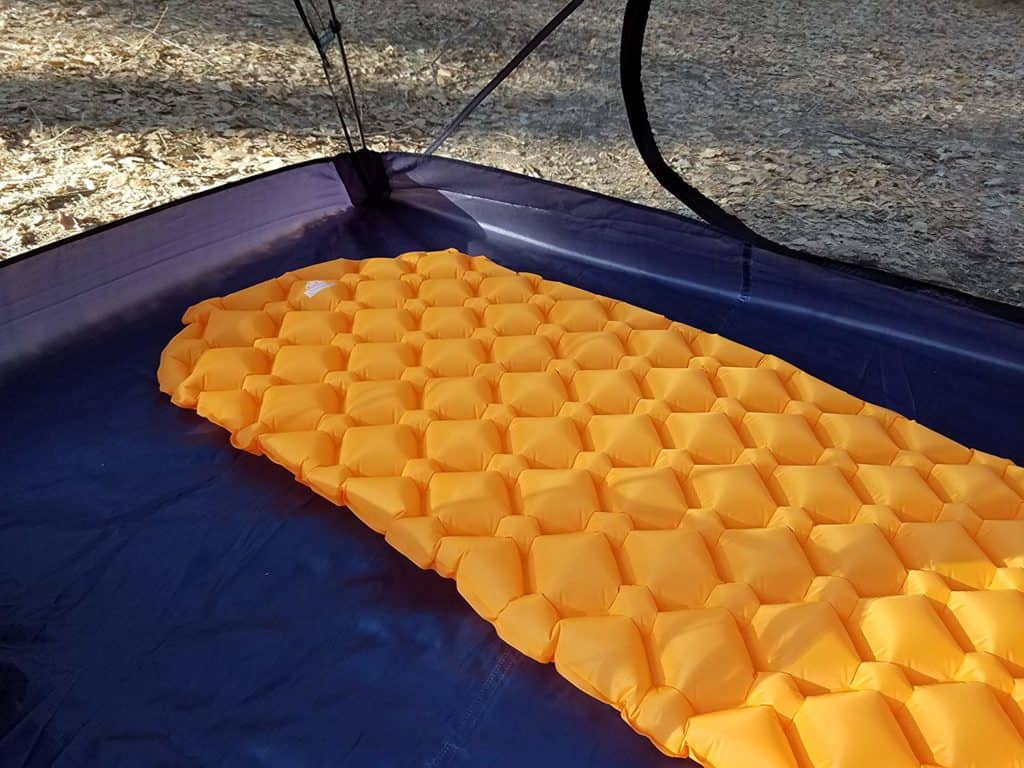
When trying to choose the best sleeping pad under $50, there are four main things you need to consider including what type of sleeping pad is best for you, how and where you plan to use the sleeping pad, what warmth or R-value do you need from the sleeping pad, and what specific features do you want your sleeping pad to have?
Types of Sleeping Pads
There are three main types of sleeping pads to choose from including air, closed-cell foam, and self-inflating. Each type of sleeping pad has both advantages and disadvantages so it’s important to look at each more closely to ensure that you pick the best sleeping pad for your needs.
Air Filled Sleeping Pad
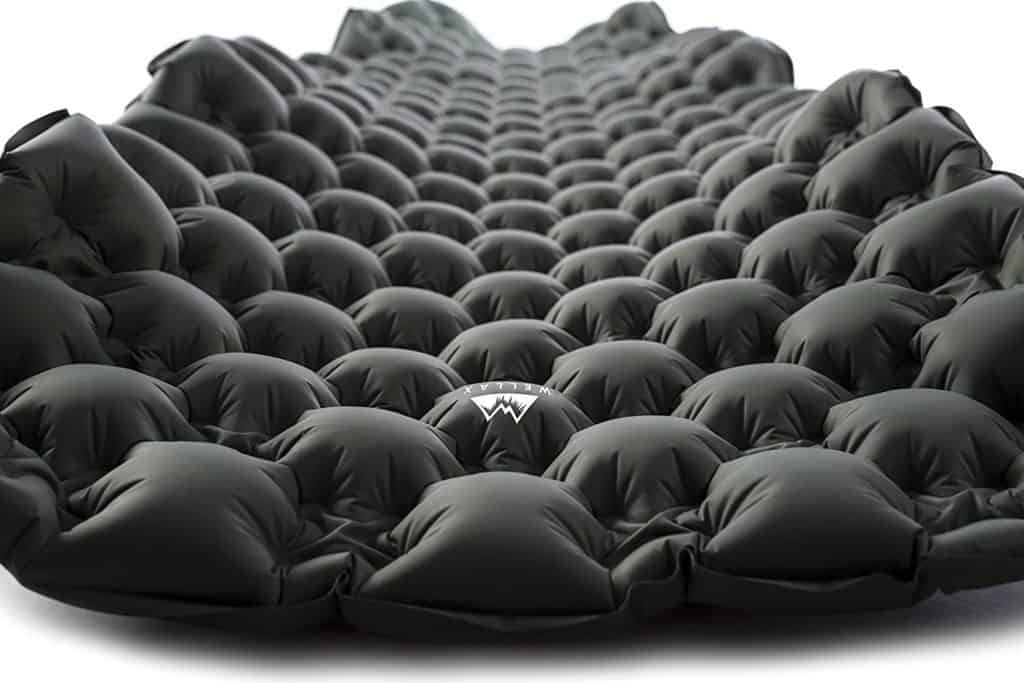
The first and most common type of sleeping pad is the air-filled sleeping pad. And for many backpackers and hikers, this will usually be the best choice due to its lightweight and compact size.
Let’s take a closer look at all of the advantages and disadvantages of this type of sleeping pad though so that you can make up your own mind.
Advantages
- Typically the lightest and most compact sleeping pad.
- Allows for adjustable firmness by adding or removing air from the sleeping pad.
- Usually has some level of R-value or insulation from the ground.
Disadvantages
- Requires manual filling of the sleeping pad with air.
- Some sleeping air pads can be extremely noisy while sleeping on them.
- Air-filled sleeping pads can potentially be punctured or lose their ability to hold air over time.
- When filled by breath the moisture in your breath can get trapped inside leading to potential bacterial or mold issues.
- The firmness of the air-filled sleeping pad can be affected by the external temperature requiring you to readjust the air pressure inside the sleeping pad.
Closed-Cell Foam Sleeping Pad
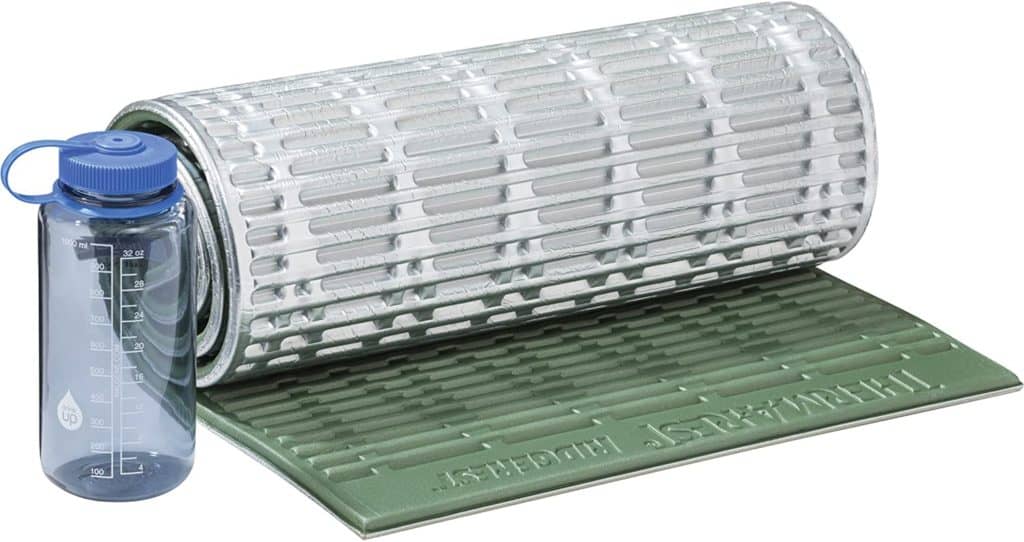
Another popular sleeping pad option among campers is the closed-cell foam pad due to its simple and no-hassle design. These pads are made up of dense foam that is filled with small closed air cells to provide cushioning from the hard ground.
Closed-cell foam pads have their own unique set of advantages and disadvantages which are list below.
Advantages
- Simple in design with very little to go wrong.
- They cannot be punctured or popped which makes them very rugged and durable.
- They provide a more stable sleeping pad compared to air-filled sleeping pads.
Disadvantages
- Cannot adjust the firmness or cushioning of the pad.
- While usually very light, they tend to be bulkier than air-filled sleeping pads.
- They do not provide as much loft as air-filled sleeping pads which can limit your sleeping position options.
Self-Inflating Sleeping Pads

The self-inflating sleeping pad is a great option for comfort as they use both foam insulation and air in order to provide a unique and comfortable experience to sleep on while camping.
They work by bringing air through a valve from the expanding foam inside the sleeping pad once unpacked. And to reverse the process to store the self-inflating sleeping pad you simply roll the sleeping pad up in order to push out and remove the air from inside.
While there are lighter and more compact versions of the self-inflating sleeping pad they are typically used more for car camping as they can be more bulky and heavy compared to either closed-cell foam or air-filled sleeping pads.
Advantages
- They usually have a high R-value and provide excellent insulation from the cold ground due to the combination of foam and air.
- You can adjust the firmness of the self-inflating sleeping pad by adding or removing air.
- They provide a lot of comfort and loft.
Disadvantages
- They can be heavier and bulkier when compared to air-filled or closed-cell foam sleeping pads.
- Self-inflating sleeping pads can be punctured or ripped.
- They tend to be more expensive when compared to air-filled or closed-cell foam pads.
Choosing the Best Sleeping Pad for Your Situation
Sleeping pads are definitely not one size fits all as each camper or hiker has specific needs and wants depending on how and where they plan to camp.
For example, the best sleeping pad under $50 for someone car camping that is mainly concerned with comfort will look very different than a backpacker’s sleeping pad that is mainly concerned with weight and compact size.
Below we have broken down what type of sleeping pad is best depending on how and where you plan to camp.
Car Camping
When car camping little to no importance should be put on weight or compact size due to the fact that your vehicle is typically located right next to your campsite. Instead, when car camping it’s best to choose thicker and larger sleeping pads that provide more comfort.
The best sleeping pads for car camping are thick self-inflating or air-filled sleeping pads.
Another option you might want to consider is to skip the standard sleeping pad altogether and instead opt for a full-blown camping air mattress. While an air mattress will definitely be bulkier and heavier than a camping sleeping pad, it will allow you to use fitted sheets and provide the most comparably feeling to sleeping at home in your bed.
Backpacking
When backpacking and choosing a sleeping pad the most important thing is how light and compact the sleeping pad is, as you will not only have to carry the sleeping pad over miles of trails but it also needs to fit comfortably in your pack.
When choosing a sleeping pad under $50 it’s also important to keep durability in mind as hiking and backpacking can oftentimes be very hard on camping gear.
The best sleeping pad for backpacking and hiking is either a lightweight air-filled or closed-cell foam sleeping pad.
Thru-Hiking
While thru-hikers have similar concerns as backpackers and hikers when choosing a sleeping pad. Due to the length of time thru-hikers hike and camp for, weight while still important, can sometimes take a back seat to durability.
This is because while thru-hikers should still be looking for a lightweight sleeping pad they also need to pay extra attention to durability to make sure their sleeping pad will be with them from the beginning to the end of their through-hike.
The best sleeping pad for thru-hikers is a closed-cell foam pad due to it’s lightweight and ultimate durability.
Winter Camping
While weight and compact size can still be important depending on what type of winter camping you are doing i.e. backpacking or thru-hiking, the sleeping pad’s R-value becomes the most important thing when winter camping.
This is because when you are winter camping you want to choose a sleeping pad that will provide you the most warmth and protection from the cold ground while sleeping.
The best sleeping pad for winter camping is a well-insulated air-filled pad or self-inflating pad.
Sleeping Pad R-Value and Insulation
When it comes to a sleeping pads R-value the main thing you need to know is that the higher the R-value the better the insulating properties and the more warmth the sleeping pad will provide.
While a sleeping pad’s, R-value might not be that important when summer camping if you are planning to camp in the spring or fall and especially during the winter than the sleeping pads R-value is very important.
This is because if you don’t have insulation from the cold ground when sleeping you are losing body heat to it which can make for a very long, cold, and uncomfortable night’s sleep.
R-values on sleeping pads typically range from a 2 which is minimally insulated to a 5 or more which is very well insulated.
If you are planning on doing any cold weather camping or winter camping then you should look for a sleeping pad that provides at least an R-value of 2.
Sleeping Pad Features
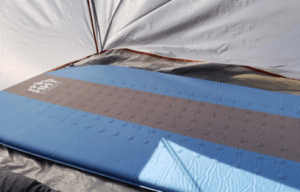
There are many sleeping pad features that separate one from another and it can help to consider these specific features when trying to choose the best budget sleeping pad for your needs.
Sleeping Pad Weight
When it comes to sleeping pads especially if you’re a backpacker or hiker there is perhaps no other feature more important than the sleeping pads weight. As a general rule of thumb, the lighter the sleeping pad the better, however, be aware that the lighter you go when it comes to sleeping pads the more you typically will have to pay for the pad.
Often times ounces are all that separates one sleeping pad from another but the more ounces you shed the easier it will to travel or backpack with the sleeping pad.
When looking at the best sleeping pads under $50, you will typically see a weight range from about 10 to 50 ounces and everything in between.
As a general rule of thumb, you want to keep the sleeping pad weight under or as close as possible to 20 ounces if you plan to hike or backpack with the sleeping pad.
If you’re looking for an ultralight sleeping pad then you should look for a sleeping pad that weighs 15 ounces or less.
Sleeping Pad Length and Width
When it comes to sleeping pad length and width you might think the longer and wider the better, however, due to weight and size considerations when camping and backpacking this is not always the case.
The standard size adult sleeping pad is usually 70 to 75 inches long and 20 to 25 inches wide.
While the perfect size sleeping pad can vary greatly from person to person, I would recommend choosing one that is at least 72 inches long and 22 inches wide.
However, if you are tall or a larger camper say 6 feet or more then you will need to choose a larger sleeping pad to accommodate for this.
Also, while on the topic of length there are sleeping pads that are shorter than standard length pads that are either called 3/4 or short length pads that ultralight campers or backpackers will sometimes use. With these shorter sleeping pads its all about weight reduction with many of them weighing less than 10 ounces.
We did not include any short length sleeping pads on this list of best sleeping pads under $50, because unless you need extreme weight reduction the weight reduction is usually not worth the trade-offs in comfort.
Sleeping Pad Inflation
While we have already discussed the different types of cushioning in sleeping pads including air-filled, closed-cell foam, and self-inflating there are many other things to consider when looking at sleeping pad inflation.
For one when you are considering an air-filled sleeping pad there are certain features that can make it faster and easier to inflate the sleeping pad such as high-volume inflation and deflation valves and a larger neck opening that allows for faster inflation with fewer breaths.
In addition, some higher-end sleeping pads offer separate inflation chambers in case one chamber were to fail or get punctured you would still have the other inflation chambers giving you some level of comfort.
Sleeping Pad Surface
While most air-filled and self-inflating sleeping pads are made from some type of ripstop nylon.
If you are a restless sleeper or looking for a quieter sleeping pad you might want to consider a sleeping pad that has a textured or brushed fabric surface to keep you on the pad throughout the night as well as to help reduce noise.
